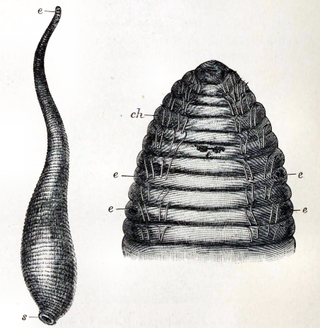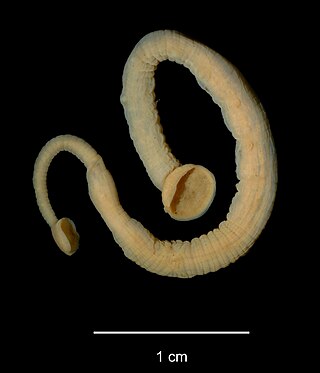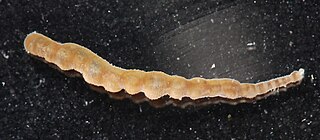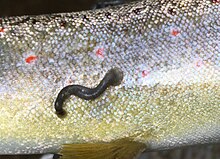
The family Argulidae, whose members are commonly known as carp lice or fish lice, are parasitic crustaceans in the class Ichthyostraca. It is the only family in the monotypic subclass Branchiura and the order Arguloida, although a second family, Dipteropeltidae, has been proposed. Although they are thought to be primitive forms, they have no fossil record.

Rhynchobdellida, the jawless leeches or freshwater leeches, are an order of aquatic leeches. Despite the common name "freshwater leeches", species are found in both sea and fresh water. They are defined by the presence of a protrusible proboscis instead of jaws, and having colourless blood. They move by "inchworming" and are found worldwide. The order contains 110 species, divided into 41 genera and three families. Members of the order range widely in length, usually between 7 and 40 mm. They are hermaphrodite. The order is not monophyletic.

The Clitellata are a class of annelid worms, characterized by having a clitellum – the 'collar' that forms a reproductive cocoon during part of their life cycles. The clitellates comprise around 8,000 species. Unlike the class of Polychaeta, they do not have parapodia and their heads are less developed.
Erpobdella obscura is a freshwater ribbon leech common in North America. It is a relatively large leech and is commonly used as bait by anglers for walleye and other sport fish. In Minnesota, live bait dealers annually harvest over 45,000 kg of bait-leeches, raising concerns of over-harvest.

Glossogobius giuris, the tank goby, is a species of goby native to fresh, marine and brackish waters from the Red Sea and East Africa through South Asia and the Indian Ocean to China, Australia and the islands of the Pacific Ocean. This species can also be found in the aquarium trade. It is also known as the bar-eyed goby, flat-headed goby and the Gangetic tank goby.

The Cymothoidae are a family of isopods in the suborder Cymothoida found in both marine and freshwater environments. Cymoithoids are ectoparasites, usually of fish, and they include the bizarre "tongue-biter", which attaches to a fish's tongue, causing it to atrophy, and replaces the tongue with its own body. Ceratothoa oestroides is one of the most devastating ectoparasites in Mediterranean aquaculture. Around 40 genera and more than 380 species of cymothoid are recognised. Species of the Cymothoidae are generally found in warmer waters and rarely in the cool and cold climates.

Leeches are segmented parasitic or predatory worms that comprise the subclass Hirudinea within the phylum Annelida. They are closely related to the oligochaetes, which include the earthworm, and like them have soft, muscular segmented bodies that can lengthen and contract. Both groups are hermaphrodites and have a clitellum, but leeches typically differ from the oligochaetes in having suckers at both ends and in having ring markings that do not correspond with their internal segmentation. The body is muscular and relatively solid, and the coelom, the spacious body cavity found in other annelids, is reduced to small channels.

Worms are many different distantly related bilateral animals that typically have a long cylindrical tube-like body, no limbs, and no eyes.

Cestoda is a class of parasitic worms in the flatworm phylum (Platyhelminthes). Most of the species—and the best-known—are those in the subclass Eucestoda; they are ribbon-like worms as adults, known as tapeworms. Their bodies consist of many similar units known as proglottids—essentially packages of eggs which are regularly shed into the environment to infect other organisms. Species of the other subclass, Cestodaria, are mainly fish infecting parasites.

Lernaeocera branchialis, sometimes called cod worm, is a parasite of marine fish, found mainly in the North Atlantic. It is a marine copepod which starts life as a small pelagic crustacean larva. It is among the largest of copepods, ranging in size from 2 to 3 millimetres when it matures as a copepodid larva to more than 40 mm as a sessile adult.

Haemopis sanguisuga is a species of freshwater leech in the family Haemopidae. It is commonly called the horse-leech, but that is due to the similarity of its appearance to the leech Limnatis nilotica, which sometimes enters the nasal cavities of livestock. Haemopis sanguisuga does not behave in this way. Another synonym for this leech is Aulastomum gulo.

Branchiobdellida is an order of freshwater leech-like clitellates that are obligate ectosymbionts or ectoparasites, mostly of astacoidean crayfish. They are found in the Northern Hemisphere and have a holarctic distribution in East Asia, the Euro-Mediterranean region and North and Central America, with the greatest species diversity being in North and Central America.
Hemibdella soleae is a marine species of leech in the family Piscicolidae and the type taxon of its genus. Found in the northeastern Atlantic Ocean, it is a parasite of flatfish such as the common sole.

Acanthobdella peledina is a species of leech-like clitellate in the order Acanthobdellida. It feeds on the skin and blood of freshwater fishes in the boreal regions of northern Europe, Asia and North America.

Piscicola geometra is a species of leech in the family Piscicolidae. It is an external parasite of marine, brackish and freshwater fishes. It was first described as Hirudo geometra by the Swedish naturalist Carl Linnaeus in his Systema Naturae in 1758.
Anna J. Phillips is an American Research Zoologist and curator of Clitellata and Cestoda at the National Museum of Natural History's Department of Invertebrate Zoology. As a parasitologist her research focuses on leeches and tapeworms, by studying their diversity, relationships, and host associations. She has traveled all over the world with her fieldwork to study the diversity of these invertebrates on a long range.

Pontobdella muricata is a species of marine leech in the family Piscicolidae. It is a parasite of fishes and is native to the northeastern Atlantic Ocean, the Baltic Sea, the North Sea, and the Mediterranean Sea.
Mark E. Siddall is a Canadian biologist and former curator at the American Museum of Natural History. Siddall has studied the evolution and systematics of blood parasites and leeches, and systematic theory. Siddall was hired as an assistant curator at the American Museum of Natural History in July, 1999 and worked there as a curator until September, 2020, when he was terminated for allegedly having violated the museum's policy prohibiting sexual relationships between staff and mentees. Siddall denied the claim.

Trachelobdella lubrica is a species of marine leech in the family Piscicolidae. It is a parasite of fish and has a worldwide distribution in the equatorial belt. It was first described in 1840 by the German zoologist Adolph Eduard Grube, the type locality being Palermo, Sicily, in the Mediterranean Sea.

Myzobdella lugubris, the crab leech, is a species of jawless leech widespread in North America, especially in central and Eastern Canada. It is an ectoparasite of fish and crustaceans, and is responsible for several dangerous conditions in fish, including lesions infected by bacteria and fungi and possibly viral hemorrhagic septicemia. It lays its egg capsules on crabs and possible other arthropods, which then disperse the eggs.
















